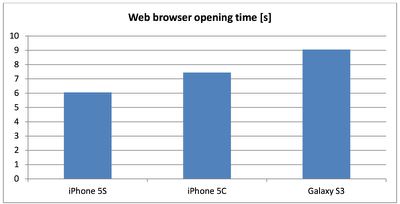New touch screen testing conducted by Finnish technology company OptoFidelity has suggested [PDF] the touch displays of Apple's iPhone 5s and iPhone 5c are less accurate than the display of the Samsung Galaxy S3, but the testing has failed to take into account that Apple has designed its iPhones to compensate for different usage angles.
Using its proprietary OptoFidelity Touch Panel Performance Tester, which compares the coordinates of touches by a robot with an artificial finger to coordinates from a touch device, the company measured the accuracy of both the iPhone 5s, the iPhone 5c, and the Galaxy S3. The video below demonstrates how the testing was carried out.
The test assigned a PASS/FAIL score when the actual touch position registered greater than ±1 mm off from the reported coordinates from the artificial finger, marking passes with green dots and fails with red dots. According to the test, both of Apple's iPhones demonstrated "extremely bad" performance near the edges and the top of the screen.

OptoFidelity suggests that this impacts both top and edge screen functionality, making it more difficult to perform tasks like accessing the Q and P keys on the virtual keyboard as they are located towards the edges of the display, but machine testing does not replicate real world usage, where the phone is held at and viewed from various angles.
iOS is designed to compensate for the angle that it expects a phone to be held at, which suggests that some of the discrepancies between screen accuracy between the iPhone 5s/5c and the Galaxy S3 may be intentional on Apple's part, in order to provide a better experience for users that are not holding their phones in static positions.
In addition to testing touch screen accuracy, OptoFidelity also took a look at touch screen latency, which was previously examined by Agawi. As with those initial tests that showed the iPhone 5 to be far more accurate than its Android counterparts, OptoFidelity had similar results with the iPhone 5s and the iPhone 5c.
Testing functionality such as web browsing opening time and camera application opening time revealed that the iPhones were more responsive than the Galaxy S3, with the iPhone 5s registering slightly faster response times.





















